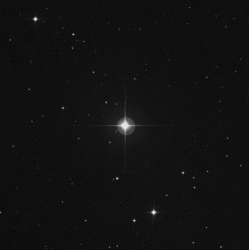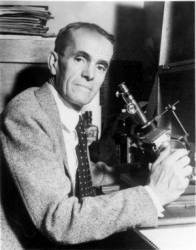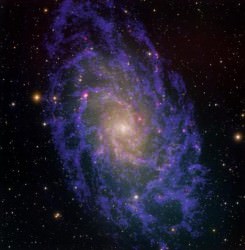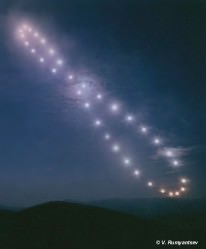Greetings, fellow SkyWatchers! Guess what? That big, ol’ bright Moon is gone and it’s time for us to go out in the dark together, you and I…. We’ll check us out a star or two… Maybe a globular cluster along the way. Perhaps enjoy a meteor shower… Or mark an astronomer’s day. Think we should chase the mighty galaxies? We can get them tiny Abells… Just grab your ‘scopes and ‘oculars and let’s read these starry fables!
Friday, December 19, 2008 – Tonight let’s familiarize ourselves with the vague constellation of Fornax. Its three brightest stars form a shallow V just south of the Cetus/Eridanus border and span less than a handwidth of sky. Although it’s on the low side for northern observers, there is a wealth of sky objects in this area.
 Try having a look at the easternmost star – 40-light-year distant Alpha. At magnitude 4, it is not easy, but what you’ll find there is quite beautiful. For binoculars, you’ll see a delightful cluster of stars around this long-term binary – but telescopes will enjoy it as a great golden double star! First measured by John Herschel in 1835, the distance between the pair has narrowed and widened over the last 172 years, and it is suspected its orbital period may be 314 years. While the 7th magnitude secondary can be spotted with a small scope – watch out – because it is a variable which may drop by as much as a full magnitude!
Try having a look at the easternmost star – 40-light-year distant Alpha. At magnitude 4, it is not easy, but what you’ll find there is quite beautiful. For binoculars, you’ll see a delightful cluster of stars around this long-term binary – but telescopes will enjoy it as a great golden double star! First measured by John Herschel in 1835, the distance between the pair has narrowed and widened over the last 172 years, and it is suspected its orbital period may be 314 years. While the 7th magnitude secondary can be spotted with a small scope – watch out – because it is a variable which may drop by as much as a full magnitude!
 For larger telescopes, set sail for Beta Fornacis and head three degrees southwest (RA 02 39 42 Dec -034 16 08) for a real curiosity – NGC 1049.
For larger telescopes, set sail for Beta Fornacis and head three degrees southwest (RA 02 39 42 Dec -034 16 08) for a real curiosity – NGC 1049.
At magnitude 13, this globular cluster is a challenge for even large scopes – and with good reason. It isn’t in our galaxy. This cluster is a member of the Fornax Dwarf Galaxy – a one degree span that’s so large it was difficult to recognize as extra-galactic – or at least it was until the great Harlow Shapely figured it out! NGC 1049 was discovered and cataloged by John Herschel in 1847, only to be reclassified as Hodge 3 (by Paul Hodge) in a 1961 study of the system’s five globular clusters. Since that time, yet another globular has been discovered in the Fornax Dwarf! Good luck…
Saturday, December 20, 2008 – Tonight is the peak of the Delta Arietid meteor shower. While most showers are best after midnight, this is an early evening shower which must be viewed before the radiant sets. The fall rate is modest – about 12 per hour… And there’s no Moon!
 Today marks the founding of Mt. Wilson Solar Observatory. It officially opened its doors in 1904. We also celebrate the birth of Walter S. Adams on this date. Born in 1876, Adams was the astronomer at Mt. Wilson who revealed the nature of Sirius B, the first known white dwarf star. Sirius B was first seen by Alvan Clark in 1862, and recently the Hubble Space Telescope precisely measured the mass of B for the first time. When Sirius is well risen tonight, why not have a go at spotting the B star for yourself?
Today marks the founding of Mt. Wilson Solar Observatory. It officially opened its doors in 1904. We also celebrate the birth of Walter S. Adams on this date. Born in 1876, Adams was the astronomer at Mt. Wilson who revealed the nature of Sirius B, the first known white dwarf star. Sirius B was first seen by Alvan Clark in 1862, and recently the Hubble Space Telescope precisely measured the mass of B for the first time. When Sirius is well risen tonight, why not have a go at spotting the B star for yourself?
Until then, let’s pretend the skies are still as dark as they were on Mt. Wilson in Adams’ time as we aim our binoculars and telescopes toward one of the most elusive galaxies of all – M33.
 Located about one-third the distance between Alpha Trianguli and Beta Andromedae (RA 01 33 51 Dec +30 39 37), this member of our Local Group was probably first seen by Hodierna, but was recovered independently by Messier some 110 years later. Right on the edge of visibility unaided, M33 spans about four Moon-widths of sky, making it a beautiful binocular object and a prime view in a low power telescope.
Located about one-third the distance between Alpha Trianguli and Beta Andromedae (RA 01 33 51 Dec +30 39 37), this member of our Local Group was probably first seen by Hodierna, but was recovered independently by Messier some 110 years later. Right on the edge of visibility unaided, M33 spans about four Moon-widths of sky, making it a beautiful binocular object and a prime view in a low power telescope.
Smaller than both the Milky Way and the Andromeda Galaxy, the Triangulum is about average in size, but is anything but average to study. So impressed was Herschel that he gave it its own designation of H V.17 – after having already cataloged one of its bright star forming regions as H III.150! In 1926, Hubble also studied M33 at Mt. Wilson with the Hooker telescope during his work with Cepheid variables. Larger telescopes often “can’t see” M33 with good reason – it overfills the field of view – but what a view! Not only did Herschel discover a region much like our own Orion Nebula, but the entire galaxy contains many NGC and IC objects (even globular clusters) reachable with a larger scope.
Although M33 might be three million light-years away, tonight it’s as close as your own dark-sky site…
 Sunday, December 21, 2008 – Today marks Winter Solstice – for the northern hemisphere, the shortest day and the longest night of the year – and the point when the Sun is furthest south. Now is a wonderful time to demonstrate for yourself our own movements by choosing a “solstice marker.” Anything from a fence post to a stick in the ground will suffice! Simply measure the shadow when the Sun reaches the zenith and repeat your experiment in the weeks ahead and watch as the shadow grows shorter…and the days grow longer!
Sunday, December 21, 2008 – Today marks Winter Solstice – for the northern hemisphere, the shortest day and the longest night of the year – and the point when the Sun is furthest south. Now is a wonderful time to demonstrate for yourself our own movements by choosing a “solstice marker.” Anything from a fence post to a stick in the ground will suffice! Simply measure the shadow when the Sun reaches the zenith and repeat your experiment in the weeks ahead and watch as the shadow grows shorter…and the days grow longer!
Tonight let’s go north for a mid-size scope challenge about two fingerwidths east-northeast of the beautiful double star Gamma Andromedae (RA 02 22 32 Dec +43 20 45). At 12th magnitude, NGC 891 is a perfect example of a spiral galaxy seen edge-on. To the mid-sized scope, it will appear as a pencil-slim scratch of light, but larger telescopes will be able to make out a fine, dark, dustlane upon aversion. Discovered by Caroline Herschel in 1783, NGC 891 contained a magnitude 14 supernova recorded on August 21, 1986. Often considered a “missed Messier,” you can add this one to your Caldwell list as number 23!
 For more advanced observers, let’s take a look at a galaxy cluster – Abell 347 – located almost directly between Gamma Andromedae and M34. Here you will find a grouping of at least a dozen galaxies that can be fitted into a wide field view. Let’s tour a few…
For more advanced observers, let’s take a look at a galaxy cluster – Abell 347 – located almost directly between Gamma Andromedae and M34. Here you will find a grouping of at least a dozen galaxies that can be fitted into a wide field view. Let’s tour a few…
The brightest and largest is NGC 910, a round elliptical with a concentrated nucleus. To the northwest you can catch faint, edge-on NGC 898. NGC 912 is northeast of NGC 910, and you’ll find it quite faint and very small. NGC 911 to the north is slightly brighter, rounder, and has a substantial core region. NGC 909 further north is fainter, yet similar in appearance. Fainter yet is the more northern NGC 906, which shows as nothing more than a round contrast change. Northeast is NGC 914, which appears almost as a stellar point with a very small haze around it. To the southeast is NGC 923 which is just barely visible with wide aversion as a round contrast change. Enjoy this Abell quest!
Until next week? Remember… Dreams really do come true when you keep on reaching for the stars!
This week’s awesome images are: Alpha Fornacis and NGC 1049 – Credit: Palomar Observatory, courtesy of Caltech, Walter Adams – Credit: Yerkes Observatory, University of Chicago, M33 – Credit: T.A.Rector (NRAO/AUI/NSF and NOAO/AURA/NSF) and M.Hanna (NOAO/AURA/NSF), Analemma – Credit: Vasilij Rumyantsev (Crimean Astrophysical Observatory)/NASA, NGC 891 and Abell 347 – Credit: Palomar Observatory, courtesy of Caltech. Thank you so much for your fine work and sharing with us!

